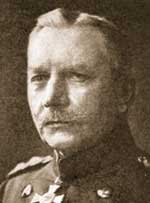10 Dywizja Cesarstwa Niemieckiego
10 Dywizja Cesarstwa Niemieckiego (niem. 10. Division (Deutsches Kaiserreich)) – niemiecki związek taktyczny okresu Cesarstwa Niemieckiego, stacjonujący w Poznaniu (Posen).
Dywizja istniała w latach 1818-1919, od 2 sierpnia 1914 pod nazwą: 10 Dywizja Piechoty (10. Infanterie-Division (Deutsches Kaiserrreich)). Wchodziła w skład V Korpusu Armii Niemieckiej.
Skład dywizji
- 19 Brygada Piechoty – (19. Infanterie-Brigade) w Poznaniu (Posen)
- 6 Pułk Grenadierów im. Hrabiego Kleista von Nollendorfa (1 Zachodniopruski) – (Grenadier-Regiment Graf Kleist von Nollendorf (1. Westpreußisches) Nr. 6) w Poznaniu (Posen)
- 46 Pułk Piechoty im. Hrabiego Kirchbacha (1 Dolnośląski) – (Infanterie-Regiment Graf Kirchbach (1. Niederschlesisches) Nr. 46) w Poznaniu (Posen) i we Wrześni (Wreschen)
- 20 Brygada Piechoty – (20. Infanterie-Brigade) w Poznaniu (Posen)
- 47 Pułk Piechoty im. Króla Bawarii Ludwika III (2 Dolnośląski) – (2. Niederschlesisches Infanterie-Regiment Nr. 47 König Ludwig III. von Bayern) w Poznaniu (Posen) i w Śremie (Schrimm)
- 50 Pułk Piechoty (3 Dolnośląski) – (3. Niederschlesisches Infanterie-Regiment Nr. 50) w Rawiczu (Rawitsch) i w Lesznie (Lissa)
- 77 Brygada Piechoty – (77. Infanterie-Brigade) w Ostrowie Wielkopolskim (Ostrowo)
- 37 Pułk Fizylierów im. von Steinmetza (1 Zachodniopruski) – (Füselier-Regiment von Steinmetz (Westpreußisches) Nr. 37) w Krotoszynie (Krotoschin)
- 155 Pułk Piechoty (7 Zachodniopruski) – (7. Westpreußisches Infanterie-Regiment Nr. 155) w Ostrowie Wielkopolskim (Ostrowo) i w Pleszewie (Pleschen)
- 10 Brygada Kawalerii – (10. Kavallerie-Brigade) w Poznaniu (Posen)
- 1 Pułk Ułanów im. Cesarza Rosji Aleksandra III (Zachodniopruski) – (Ulanen-Regiment Kaiser Alexander III. von Rußland (Westpreußisches) Nr. 1) w Miliczu (Militsch) i w Ostrowie Wielkopolskim (Ostrowo)
- 1 Królewski Pułk Strzelców Konnych (niemiecki) – (Königs-Jäger-Regiment zu Pferde Nr. 1) w Poznaniu (Posen)
- 10 Brygada Artylerii Polowej – (10. Feldartillerie-Brigade) w Poznaniu (Posen)
Najsłynniejsi dowódcy dywizji
Zobacz też
Bibliografia
- Claus von Bredow, bearb., Historische Rang- und Stammliste des deuschen Heeres (1905).
- Hermann Cron et al., Ruhmeshalle unserer alten Armee (Berlin, 1935)
- Hermann Cron, Geschichte des deutschen Heeres im Weltkriege 1914-1918 (Berlin, 1937).
- Günter Wegner, Stellenbesetzung der deutschen Heere 1815-1939. (Biblio Verlag, Osnabrück, 1993), Bd. 1.
- Histories of Two Hundred and Fifty-One Divisions of the German Army which Participated in the War (1914-1918), compiled from records of Intelligence section of the General Staff, American Expeditionary Forces, at General Headquarters, Chaumont, France 1919 (1920).
Linki zewnętrzne
- 10.Infanterie-Division (Chronik 1914/1918). 1914-18.info. [zarchiwizowane z tego adresu (2007-09-27)]. (niem.)
Media użyte na tej stronie
War Ensign of the en:German Empire from 1903-1919 (correction of date shown on image which shows 1918). Based on image of coat of arms at [1]. Currently unable to add further details for crown or further details to sceptor due to lack of high-quality images of the coat of arms.
August Karl von Goeben.
Autor: Radomil talk 13:05, 26 March 2007 (UTC), Licencja: CC-BY-SA-3.0
Ravelin I of Fort Winiary in Stronghold Poznań
Otto von Emmich (1848-1915), german general












